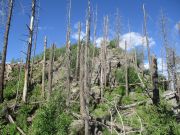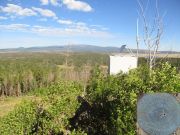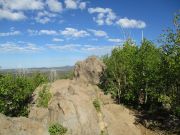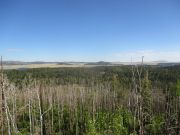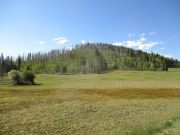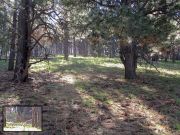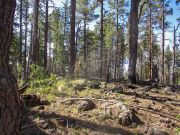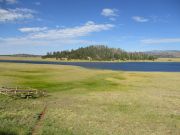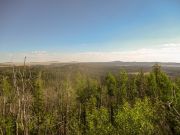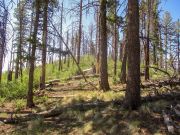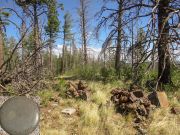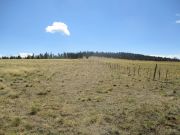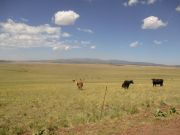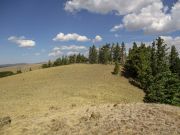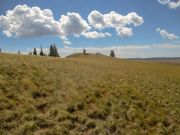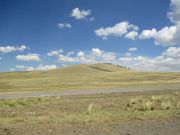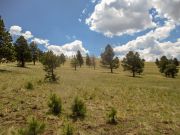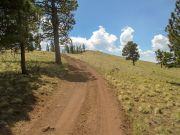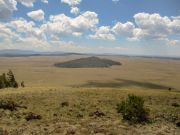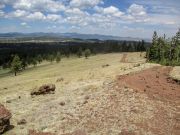
The Mountains of Arizona
• www.surgent.net
|
|
Big Lake Knoll • S U Knoll I spent half a day hiking a handful of small hills on the elevated plateau east of Mount Baldy, in eastern Arizona. These hills were of interest for two reasons: they all had elevations of 9,000 feet or higher, and they were all ranked (except for one). None of the hikes were too long, the longest being under 2.5 miles. I was on the road early, leaving Payson at 4:20 a.m., the eastern sky just barely lighting up. I was above the rim and on the plateau and most of the way to Show Low before the sun actually started to rise. Traffic was light and I was able to get through Show Low and Pinetop/Lakeside easily, then across the White Mountain Apache Nation to state route AZ-273, the highway to the Sunrise Ski Area. Everything on the White Mountain Nation is closed for the time being, due to the pandemic. However, the roads are still open. Up here, the hills are all called knolls, since all of them have a rocky caprock at its summit. My plan was to hike the southernmost one first, being Big Lake Knoll, then work northwards and exit the area near Eagar.
Date: June 13, 2020
• Elevation: 9,415 feet
• Prominence: 415 feet
• Distance: 2 miles
• Time: 55 minutes
• Gain: 365 feet
• Conditions: Sunny and pleasant
Arizona
•
Main
•
PB
•
LoJ
•
Interactive map
Route AZ-273 wanders through the high country east of Mount Baldy. This was my first time here since 2014, and today, there were work trucks staged as the highway is evidently being repaved in parts, with brand-new asphalt. In about twenty minutes, I was at the Big Lake Recreation Area, with "Big Lake" itself and the surrounding camping areas. Big Lake Knoll rises about two miles south of the campground. It is possible to start the hike from the campground itself.
The highway designation ends at the turn-off to the campground. But the road continues south, still paved and striped, now just a forest road, FR-249. I want another mile on it to FR-249E, heading west about a half mile, parking at the Indian Spring Trailhead. It was 7 a.m., sunny and still, temperature about 60 degrees. I was the only one here.
This area, along with hundreds of thousands of nearby acres, was burned in the Wallow Fire of 2011, the state's biggest in terms of area. In the immediate area, there were sections of forest that seemed to be spared of the fire, and sections that were obliterated. I would see both. The trail started in a meadow, then enters into the forest, which looked more alive than dead. The trail drops about 40 feet and wanders a bit, but then starts a gentle uphill, coming to a junction with the spur trail to the summit (half a mile, said the sign).
It was in this last half-mile to the summit that the devastation was most evident. Whole stands of trees were burned. They still stand, but are blackened and dead. A lot of new growth was evident, the blackened trees rising above a heavy undercarriage of green.
The trail gains but never steeply. As I neared the top, the giant rock outcrop at the summit became visible, this being the knoll they speak of. Here, more of the dead trees were on their sides. I hopped over a number of logs, and under two or three. The trail curls around the north face of the summit knoll, then lets out onto a jeep track that comes up from the south. I found the footpath to the top, and was on the summit quickly, about 30 minutes after starting.
The summit is one obvious large rock. I walked past it at first to the small metal shed building and the benchmark, taking a few photos of surrounding hills, knolls and the giant Mount Baldy, as well as the surrounding forest, both alive and dead. I then walked back to the rock and stood atop it. I could not find a register. The lookout tower that is cited on the maps is not here. It was burned in the Wallow Fire. An image of it can be seen here.
Up here, there was a slight breeze but it was very comfortable. There were few clouds in the sky and overall, things were calm. I walked down the same way and was back to my car in twenty minutes, the round trip taking just under an hour. It was just shy of 8 a.m., and my next objective was just a few miles north.
Elevation: 9,417 feet
• Prominence: 357 feet
• Distance: 0.8 mile
• Time: 25 minutes
• Gain: 330 feet
PB
•
LoJ
I got back on AZ-273 and drove about three miles to where it meets AZ-261. The S U Knolls lie on either side of AZ-261, the southern one being highest. This knoll lies near the AZ 261/273 junction, and across from Crescent Lake, part of the Big Lake Recreation Area (said a sign).
By itself, S U Knoll is not worth the trouble to drive all this way, but for me, it would be a perfect second hike after Big Lake Knoll. I parked in a pullout on AZ-273, near S U Knolls Spring. I was due west of the top. The hill is open down below but forested higher up.
I started uphill, crossing under a fence. Soon I was in the trees, but undergrowth was light. The top was up ahead. Then I heard rustling, then saw two groups of deer scamper past. I got one in an image, although I was shooting blindly. After they had bailed, I angled left a little and achieved the top from the north.
The top is wooded, as was the west slope of the hill, but the north slopes were burned, with the same combination of dead blackened snags and dense green undergrowth. I was on the margin where I stood.
The top has no views, there were no registers or benchmarks, so I just turned around and hiked down, back to my car in about twenty minutes. This had gone fast, as expected, and I had fun, although admittedly I was only here to add another peak to my totals. The opportunity was too good to pass up.
Next on the agenda were Pat, Rudd and Wahl Knolls, three hills kind of nearby one another about ten miles to the north along AZ-261. It was still not yet 9 a.m.. I was there quickly, Pat Knoll up next.
Elevation: 9,661 feet
• Prominence: 381 feet
• Distance: 1.6 miles
• Time: 50 minutes
• Gain: 315 feet
• Conditions: Sunny, a tad breezy
PB
•
LoJ
I drove north on AZ-261, then got onto FR-90, which runs east a couple miles to FR-285. Parts of FR-90 get kind of high on the south slopes of Rudd Knoll. The road itself is a good road with a solid tread and no ruts or unnecessary rocky portions. In a matter of minutes I was at the junction of FR 90 and 285. I parked in a wide spot on FR-285, a few dozen feet south of the junction. Here, there are no trees. It's all one big gigantic meadow.
I started walking on a direct line toward Pat Knoll, the gradient so slight as to be barely noticeable. I was blocked by a barbed-wire fence, but here, the fence was barely attached to the ground and I was able to step over it in one area where it leaned heavily.
I entered into the trees and followed my nose, angling slightly left to catch a ridge. I happened upon a jeep track, which was unexpected. I followed it briefly, but it dropped down and away, so I left it and started upslope again, busting through easy grass and low brush to gain the ridge. Here, there is new growth, the big Wallow Fire having burned parts of this section of forest (but not all).
For about a hundred feet, I encountered the only bushwhacking of the day, as I weaved through these young trees. Soon, the terrain opened again and I approached the top from the northwest, weaving again through low brush. I was on the top quickly.
A lookout tower once stood here, but there was no evidence of it today. The top featured a couple rock piles and a register, plus a newer unstamped benchmark in a concrete pad. The lookout probably was removed long ago, not a casualty of the Willow Fire. I had good views to the southeast. I could see big Escudilla Mountain. A big helicopter was buzzing low in the valley to the east.
I hiked out the same way, and was back to my car in a little under an hour. By now, the winds were picking up, a steady breeze. It wasn't too bad, but it was consistent. The clouds were starting to build, too.
Elevation: 9,572 feet
• Prominence: 272 feet
• Distance: 0.4 mile
• Time: 20 minutes
• Gain: 220 feet
• Conditions: Much breezier
PB
•
LoJ
I drove back on FR-90 a couple miles to situate myself on the south slope of Rudd Knoll, parking in a small pullout hard against the north slope. There were cattle here, most of them downslope, some on the road and a couple above me. They all seemed to be heading downhill, where I could see a whole bunch of them collecting. I wonder what they think when they look at you.
This would be a very short hike. I did not even wear a day pack. I just barged up slope and in about ten minutes, had achieved the top ridge. Once on top, I could see the summit rocks about a hundred feet away to the west, and about ten feet higher. I walked over to them and stood on the highest one. I found no register or benchmark.
Another rock outcrop about a hundred feet more west looked as high, so I walked to those rocks and tagged them, but I felt the middle rocks were the highest. I just hiked on a beeline back to my car, gone about 20 minutes. The wind was really blowing, a steady 25 m.p.h. breeze, which was strong enough to make my eyes water.
Elevation: 9,768 feet
• Prominence: 588 feet
• Distance: 2.4 miles
• Time: 1 hour
• Gain: 220 feet
• Conditions: Extremely windy
PB
•
LoJ
•
USGS BM Datasheet
Wahl Knoll lies across the highway (AZ-261) and could easily be hiked from the highway. However, I was aware of a track that curls in from the north and west, and wanted to follow it rather than deal with grass. I drove on AZ-261 about a mile, then got on FR-409, which angles west, cutting across the north slopes of Wahl. Here, there is more forest and not much meadow.
I drove in about a mile, the road trending southwest now. It comes to a cattle grate, after which it makes a bend to the right. Just before the grate, on the left (south), is a rough un-numbered track that should connect to the main track to the top. I would find out soon enough. I parked under a big pine tree in the shade and started hiking, the time about 10:30 a.m..
I walked up this track, which was rough at first, but then it smoothed out and leveled, and in about a quarter mile, connected to the main track (FR-8352 on the map, but no signs here to confirm that). This track starts farther back, but judging by the relative quality of the tracks, it appears the track I was on has become the de-facto route to the top.
I followed the track as it slowly curved around the slopes. A couple massive trees lied across the track forcing a detour downslope near the Bill Riley Tank. The track generally skirts the margin of the trees and the open terrain.
Toward the end, the track steepened, and soon, achieved the main ridge. I turned right and walked to the top, which was open with a rocky crown, a benchmark, and what looks like a geocache tin. When I opened it, it was full of about a couple hundred separate slips of paper. I did not sign any and quickly closed it. A few blew away in the stiff wind.
The views were great from up here. I was about 400 feet above the plains, and had great views to the west, south and east. The clouds were building and shutting out the sun for minutes at a time. None of them looked big enough to develop into thunderheads, it being too early in the season for that.
The wind was really strong by now, sustained in the 30s, gusts into the 50s. It was strong enough so that if I stood in a normal stance, it would push me. I had to plant my feet and hunker into the wind just to stay in one place. It was a cool wind and uncomfortable. Thus, I did not linger long up here. I enjoyed the hike and the views, but needed to get out of the wind.
Once back into the trees, the wind mitigated but never let up. I was back to my car in about an hour. Today had gone great, five little bumps to add to my totals. I had hiked these much faster than I was expecting. Now I had a half day to kill. What to do?
I drove down AZ-261. It drops steeply a couple thousand feet, meeting AZ-260 a little west of Eagar. Down lower, the temperature was much warmer, into the 80s ... and it was very windy, too. I thought about hiking some of the volcanic mounds in the area but none of them really excited me and especially not with the wind.
Instead, I chose to do a little sight-seeing and scouting. I drove US-191 from Springerville into St. Johns, the first time I had been on this stretch of highway, and only my second time in St. Johns. The land here is rocky canyons, generally more "down" than "up", with interesting eroded hills and bluffs fronting the Little Colorado River, which runs through here. I drove by Lyman State Park, which looks like a fun place to visit. The drive was prettier than I was expecting.
Once in St. Johns, I headed west, aiming back for Show Low. St. Johns is nothing special, a town that time forgot, it seems. But it is not a bad place. I stayed here in 2007 the night after my epic evening out on Chicoma Peak in New Mexico.
I drove back to Show Low, stopping for snacks and to change into more comfortable clothes, and then drove home, arriving home about 3 p.m.. The wind was heavy the whole way, blowing dust and leaves and small branches across the highway. I could feel my car be buffetted by the wind. I wonder how those massive camper trailers do. Those damn things are basically big metal sails. I could see some lean with the wind. Fortunately for me, the traffic was not heavy, and by the time I was in Payson, the winds had died down a lot.
|
|


